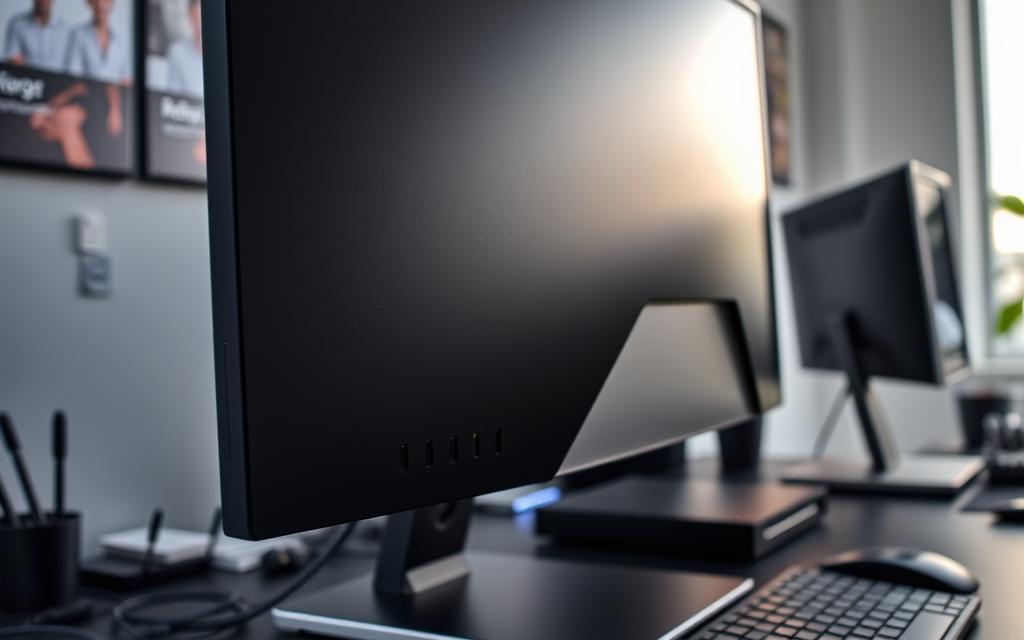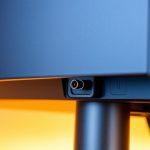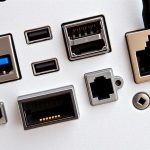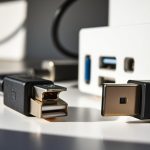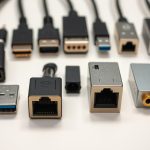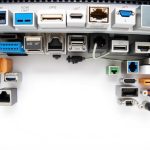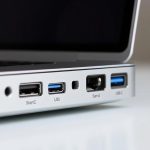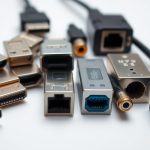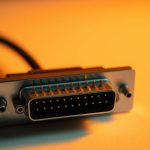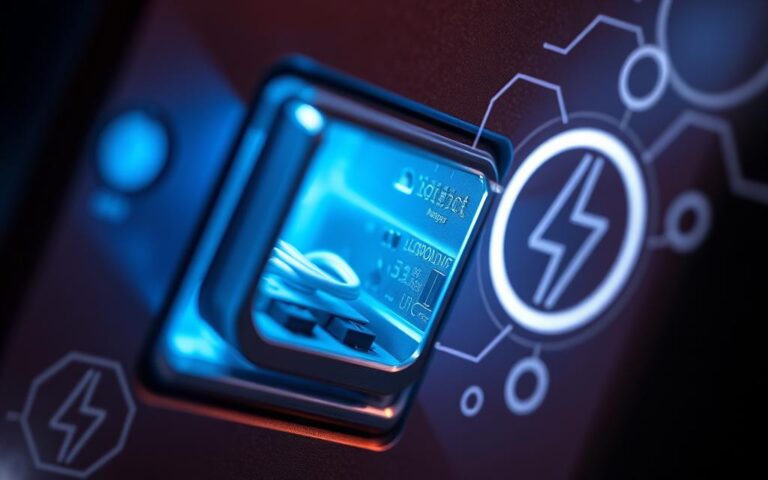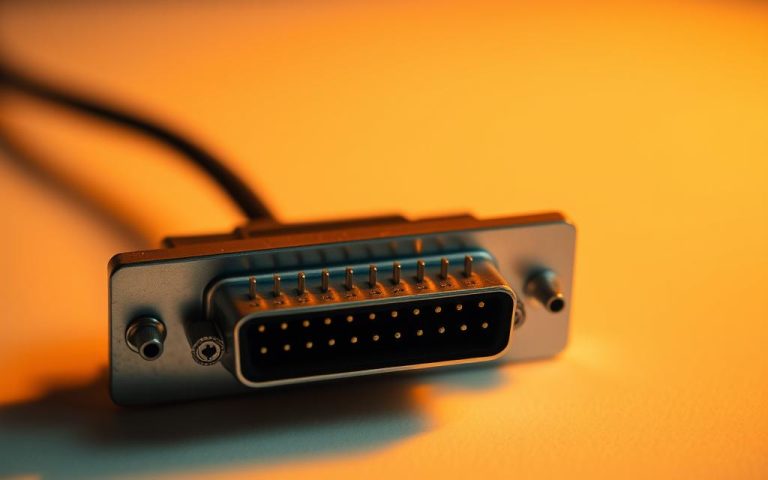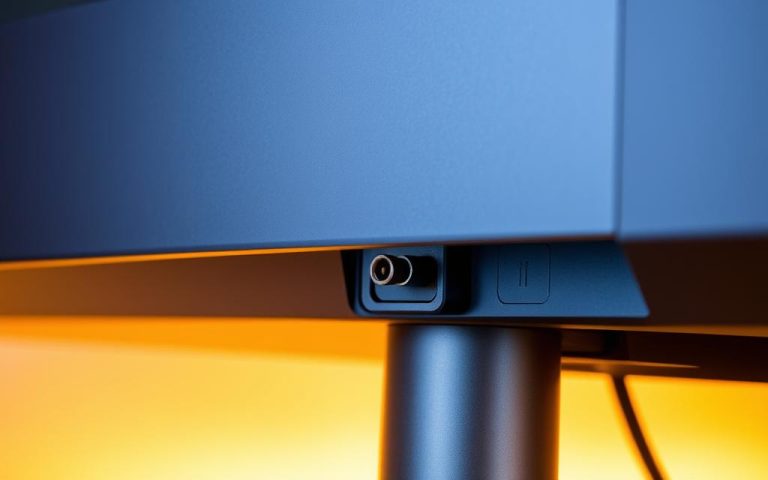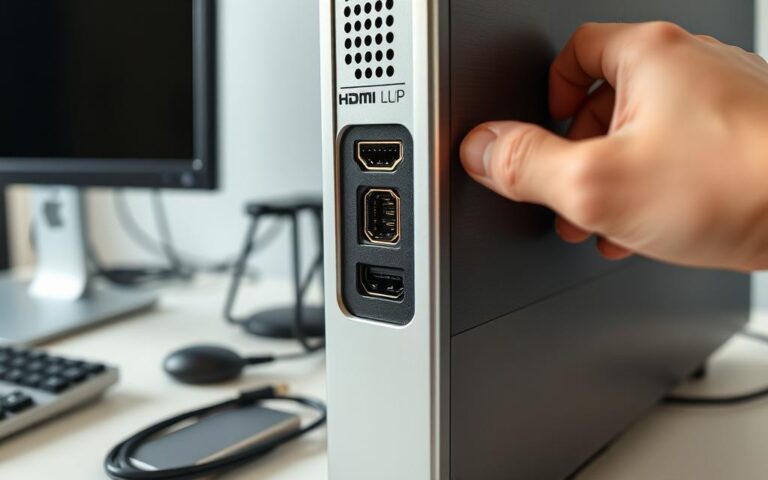Do Computer Monitors Have USB Ports?
Modern computer monitors now come with USB ports. This makes them more versatile for users. These ports let you connect devices like keyboards, mice, and phones directly to the monitor. It makes transferring data easy and helps manage devices better.
We will look into the different types of USB connectivity. You’ll learn about their uses, benefits, and important features. This will give you a clear idea of how useful they are.
Understanding USB Ports on Monitors
USB ports help our monitors talk to and power different devices. This section explains USB ports and the various types seen on monitors today.
What are USB Ports?
Universal Serial Bus (USB) ports let us connect things like phones and keyboards to computers. They move data, charge devices, and link other gear to our computers. As tech gets better, USB ports improve to make our gadgets work smoother together.
Types of USB Ports Found on Monitors
Monitors come with different USB ports, each has its benefits:
| USB Type | Functionality | Power Delivery Capability | Common Usage |
|---|---|---|---|
| USB-A | Host connection for peripherals | Data transfer, power delivery | Mice, keyboards, external drives |
| USB-B | Upstream connection to computer | Limited power delivery | Monitor USB hub |
| USB-C | Versatile for data, video, and power | Up to 240W, depending on voltage | Modern devices, laptops |
Knowing the differences between USB port types helps us set up our workspaces better. USB-C is especially useful. It lets you connect devices, transfer data quickly, and power up, all of which are key in today’s world of multitasking. Learning about these connections can make using our devices easier and more productive.
Do Computer Monitors Have USB Ports?
USB ports on monitors make workspaces more effective and tidy. They help users connect several devices easily. This is especially useful when many devices need to hook up to one computer.
Main Functions of USB Ports on Monitors
USB ports on monitors let you plug in devices like keyboards and storage drives. This means you don’t have to reach around your computer to connect stuff. It makes working smoother and more comfortable.
These ports are great for moving data quickly, too. For instance, USB 3.0 ports on newer monitors are much faster than old ones. They can even power up your devices while you use the monitor. This is handy for big files or streaming videos in high quality.
The Importance of USB Hubs in Workspaces
Nowadays, USB hubs built into monitors are key for a tech-friendly desk. They offer extra USB ports, so your computer’s ports aren’t all taken. This means less mess and more devices connected at once, making work easier.
People in jobs like graphic design or data analysis really benefit from these hubs. They allow for a lot of devices to be connected without cable clutter. This setup boosts efficiency and keeps the workspace neat.
Common Types of USB Connections
Getting to know the different USB types is key for better connectivity and performance. USB-A, USB-B, and USB-C are three main USB connections. They each have their own roles in connecting devices, moving data, and supplying power.
USB-A: The Most Common Connection
USB-A connections are widely used in today’s devices. They are great for transferring data and powering devices. Things like keyboards and memory sticks often use them. Their common use makes them a top choice for many. USB-A connectors need to be correctly aligned to connect, as they can only fit one way.
USB-B: Functions and Limitations
USB-B connections are mostly seen in monitors. They send data to a computer. Their availability is just “Okay,” which is less than USB-A. USB-B ports can’t power devices, which limits their use. They are often found in printers and external hard drives for data transfer.
USB-C: The Versatile Connection
USB-C is known for its versatility. It supports power delivery and data transfer, like USB-A, but is reversible. Its availability is “Great.” It can power up big devices like laptops with up to 240W. USB-C also supports video output through DisplayPort Alt Mode, perfect for connecting laptops to monitors. This feature improves the experience in multi-device setups.
| USB Type | Availability | Power Delivery | Data Transfer Speed | Reversible |
|---|---|---|---|---|
| USB-A | Excellent | Yes (for devices) | Up to 10 Gbps (USB 3.1) | No |
| USB-B | Okay | No | Up to 5 Gbps (USB 3.0) | No |
| USB-C | Great | Yes (up to 240W) | Up to 80 Gbps (USB4 V2) | Yes |
Advantages of USB Ports on Monitors
USB ports on monitors offer key benefits that improve the user experience. These include making it easier to connect devices, faster data transfer, and charging devices directly. With users moving towards more efficient work setups, these benefits become more vital.
Convenience of Device Connectivity
USB ports on monitors allow for easy connection of devices without needing extra hubs. This setup makes managing devices simpler and gives quick USB access. In work settings, this convenience helps speed up tasks and boosts productivity.
Data Transfer Efficiency
Monitors with USB ports provide quicker data transfer speeds. They can move large files quickly thanks to USB 3.0 or newer versions. This speed boost aids in task efficiency and enhances overall workflow.
Charging Capabilities for Devices
Many monitors with USB ports can also charge devices like phones and tablets. This feature helps users keep their devices powered while working. With new EU rules on USB-C chargers, these ports will be even more important. They’ll ensure devices stay compatible and convenient to charge. Learn more about USB-C monitors at everything you need to know.
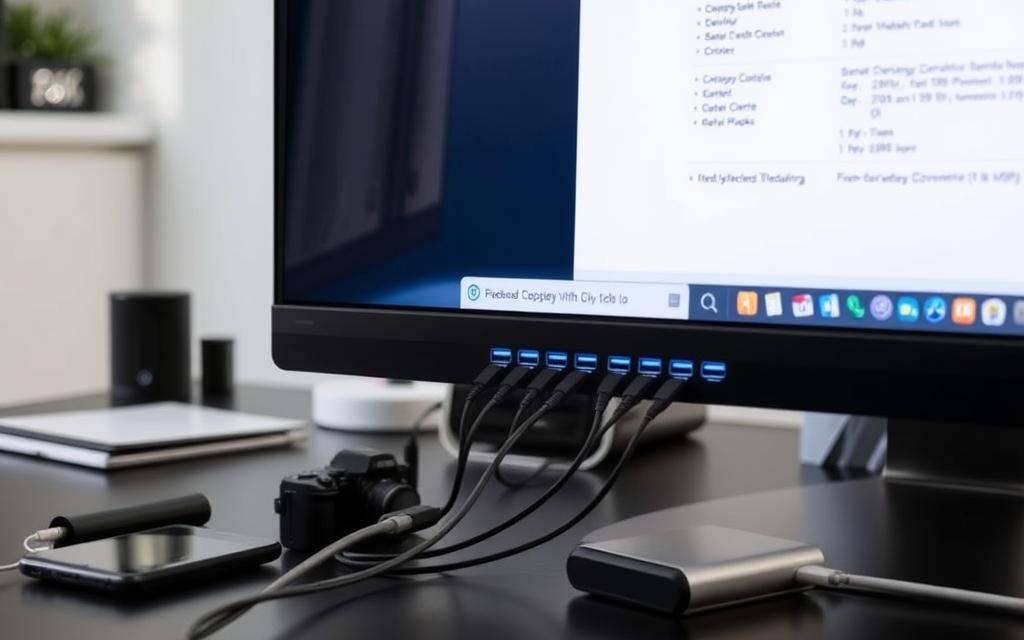
Key Features of Monitors with USB Ports
Monitors with USB ports come with features that boost both usability and performance. These features help users pick the best monitor for their needs. This includes understanding the USB hub features and power delivery options.
USB Hub Functionality
Monitors with USB hub features let you connect many devices at once. This is great for workspaces, making it easy to use peripherals like keyboards and mice. You connect the monitor to the computer with a USB Type-A to USB Type-B cable. This makes all downstream ports on the monitor work, helping to keep your desk free from extra cables.
Power Delivery Specifications
USB ports have different power delivery abilities, with USB-C offering higher wattage, sometimes over 96W. USB-A ports usually have a lower power output. It’s important to know these USB specs when choosing a monitor. This ensures it can charge devices effectively. USB-C monitors can charge gadgets like laptops and smartphones while they act as extra screens. When looking at a USB-C monitor, check its power output to make sure it fits your devices.
Conclusion
Monitor USB ports add great value by improving functionality and ease of use. They allow easy connection of devices, boosting productivity. This is key for tasks like video editing or simple web browsing. With USB-C standards, high speeds of up to 40 Gbps are possible. Plus, they support high-power needs up to 100W for large monitors, without needing extra power sources.
As people use more monitors, USB ports become even more useful. They help with multitasking, making work smoother in professional settings. This leads to better productivity and workflow. Having USB ports on monitors offers a smart way to handle multiple tasks at once.
The importance of monitor USB ports is bound to increase with technology advancements. They meet the needs of today’s users, pointing towards better computing experiences. Choosing a display with these ports is becoming more essential for modern setups.
FAQ
What are USB ports found on computer monitors?
USB ports let computers talk and power up external gadgets. They help move data, charge devices, and connect extra equipment.
What types of USB ports can I find on a monitor?
You’ll mostly see USB-A, USB-B, and USB-C types on monitors. USB-A connects everyday gadgets. USB-B links to computers, and USB-C does it all, including video transfer.
What functions do USB ports on monitors serve?
USB ports make hooking up different devices easy. They’re great for transferring data and charging, cutting down the need for more hubs.
Why are USB hubs important in workspaces?
USB hubs in monitors let you plug in many devices at once. This saves computer USB spots and boosts your work efficiency.
What is USB-A, and why is it important?
USB-A is a common connection for devices like keyboards. It’s good for moving data and powering gadgets, but it only plugs in one way.
How does USB-B function compared to other USB types?
USB-B mainly sends data to the computer. It doesn’t power devices. It’s not as versatile as USB-A or USB-C.
What makes USB-C a versatile choice?
USB-C can do a lot, like transferring data fast and sending video. It can also power devices better, making it great for new tech.
How do USB ports enhance device connectivity?
With USB ports on monitors, there’s no need for extra gear. They make connecting devices straightforward, especially important for work.
What are the data transfer speeds associated with USB ports on monitors?
USB ports, especially those with USB 3.0 or newer, offer fast data transfer. This makes work processes smoother and more efficient.
Do USB ports on monitors support charging devices?
Yes, many monitor USB ports can charge devices. This is handy for keeping your gadgets powered while you’re busy.
What is the functionality of USB hubs in monitors?
Monitors with USB have built-in hub features. This allows connecting several devices at once. Just connect via a USB Type-A to USB Type-B cable.
What power delivery capabilities do different USB ports have?
USB ports offer varied power, with USB-C often delivering more, sometimes over 96W. While USB-A gives less power, knowing this lets you choose the right monitor for your needs.

